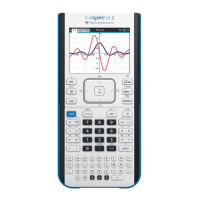TI-Nspire™ Reference Guide 89
seq()
Catalog
>
seq(Expr, Va r, Low, High[, Step]) ⇒ list
Increments Va r from Low through High by an increment of Step,
evaluates Expr, and returns the results as a list. The original contents
of Va r are still there after seq() is completed.
The default value for Step = 1.
Press Ctrl+Enter /· (Macintosh®: “+Enter) to
evaluate:
seqGen()
Catalog
>
seqGen(Expr, Var , depVar, {Var 0, Va rM a x}[, ListOfInitTerms
[, Va rSt ep [, CeilingValue]]])
⇒ list
Generates a list of terms for sequence depVar(Va r)=Expr as follows:
Increments independent variable Va r from Va r 0 through Va r Ma x by
Va rS te p, evaluates depVar(Var ) for corresponding values of Va r
using the Expr formula and ListOfInitTerms, and returns the results
as a list.
seqGen(ListOrSystemOfExpr, Va r , ListOfDepVars, {Var 0, Va r Ma x }
[, MatrixOfInitTerms [, Va rSt ep [, CeilingValue]]])
⇒ matrix
Generates a matrix of terms for a system (or list) of sequences
ListOfDepVars(Va r )=ListOrSystemOfExpr as follows: Increments
independent variable Va r from Va r0 through Va rM a x by Va r St ep ,
evaluates ListOfDepVars(Va r ) for corresponding values of Var using
ListOrSystemOfExpr formula and MatrixOfInitTerms, and returns
the results as a matrix.
The original contents of Va r are unchanged after seqGen() is
completed.
The default value for Va rS te p = 1.
Generate the first 5 terms of the sequence u(n) = u(n-1)
2
/2,
with u(1)=2 and Va rSt e p=1.
Example in which Var0=2:
System of two sequences:
Note: The Void (_) in the initial term matrix above is used to
indicate that the initial term for u1(n) is calculated using the
explicit sequence formula u1(n)=1/n.

